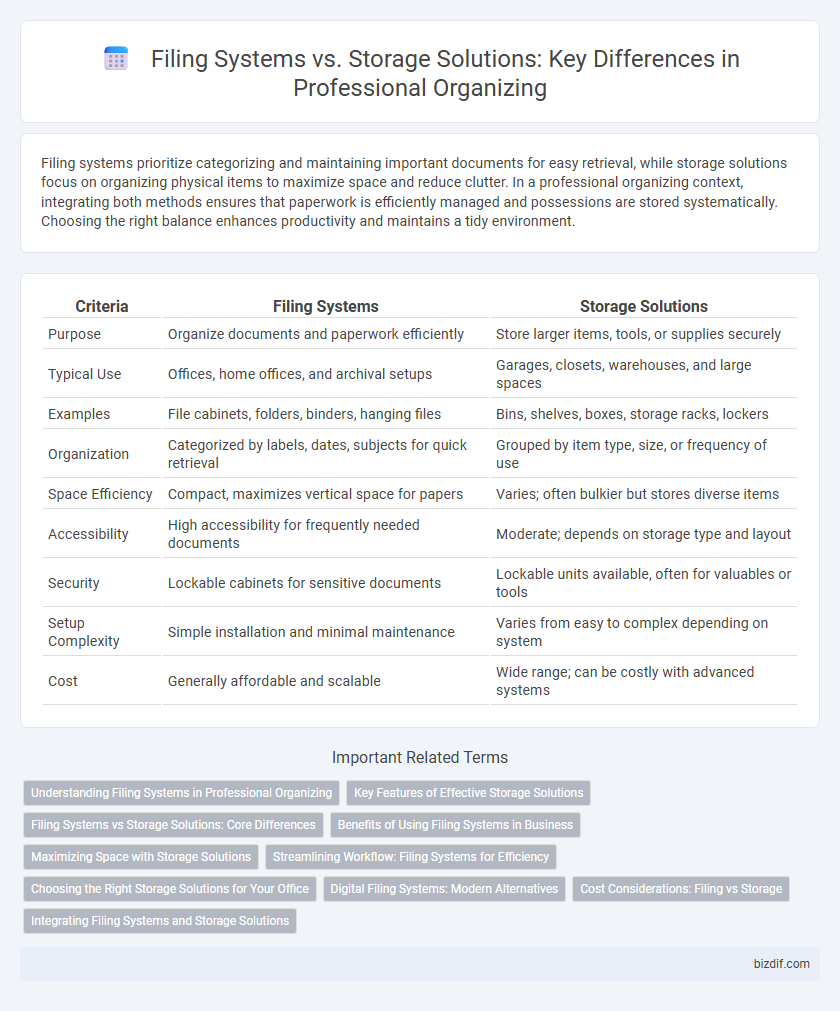Filing systems prioritize categorizing and maintaining important documents for easy retrieval, while storage solutions focus on organizing physical items to maximize space and reduce clutter. In a professional organizing context, integrating both methods ensures that paperwork is efficiently managed and possessions are stored systematically. Choosing the right balance enhances productivity and maintains a tidy environment.
Table of Comparison
| Criteria | Filing Systems | Storage Solutions |
|---|---|---|
| Purpose | Organize documents and paperwork efficiently | Store larger items, tools, or supplies securely |
| Typical Use | Offices, home offices, and archival setups | Garages, closets, warehouses, and large spaces |
| Examples | File cabinets, folders, binders, hanging files | Bins, shelves, boxes, storage racks, lockers |
| Organization | Categorized by labels, dates, subjects for quick retrieval | Grouped by item type, size, or frequency of use |
| Space Efficiency | Compact, maximizes vertical space for papers | Varies; often bulkier but stores diverse items |
| Accessibility | High accessibility for frequently needed documents | Moderate; depends on storage type and layout |
| Security | Lockable cabinets for sensitive documents | Lockable units available, often for valuables or tools |
| Setup Complexity | Simple installation and minimal maintenance | Varies from easy to complex depending on system |
| Cost | Generally affordable and scalable | Wide range; can be costly with advanced systems |
Understanding Filing Systems in Professional Organizing
Understanding filing systems in professional organizing involves categorizing documents by type, priority, or frequency of use to streamline retrieval and maintain order. Efficient filing systems incorporate labeled folders, color coding, and digital backups to reduce clutter and save time. Unlike general storage solutions, filing systems are designed specifically to optimize information management and enhance workflow productivity.
Key Features of Effective Storage Solutions
Effective storage solutions prioritize easy accessibility, maximizing vertical and horizontal space utilization, and adaptable compartments for various item sizes. Durable materials and clear labeling systems enhance longevity and organization efficiency, reducing retrieval time. Integration with digital tools for inventory management further optimizes storage performance.
Filing Systems vs Storage Solutions: Core Differences
Filing systems prioritize systematic categorization and quick retrieval of documents using labels, folders, and indexed digital databases, enhancing workflow efficiency in professional environments. Storage solutions emphasize maximizing physical or digital space through bins, shelves, or cloud storage without necessarily organizing contents for easy access. Understanding these core differences helps professionals select tools that balance accessibility with capacity, optimizing organization strategies for specific needs.
Benefits of Using Filing Systems in Business
Filing systems in business enhance efficiency by enabling quick retrieval of important documents, reducing time wasted on searching for files. They improve organization through systematic categorization, which supports better record keeping and compliance with legal regulations. Structured filing systems also minimize physical clutter, creating a professional workspace that boosts productivity and promotes effective information management.
Maximizing Space with Storage Solutions
Storage solutions maximize space by utilizing vertical areas, underutilized corners, and multi-functional furniture, creating efficient zones for different items. Unlike traditional filing systems that prioritize document categorization, storage solutions emphasize adaptability and accessibility for diverse belongings. Implementing customized shelving, stackable bins, and modular units optimizes space utilization and enhances overall organization in any environment.
Streamlining Workflow: Filing Systems for Efficiency
Filing systems enhance workflow efficiency by providing structured categorization and easy retrieval of documents, reducing time spent searching for important files. Unlike general storage solutions, filing systems use labels, indexing, and hierarchy to ensure consistent organization tailored to work processes. Implementing digital or physical filing systems streamlines task management and boosts productivity by minimizing clutter and maximizing accessibility.
Choosing the Right Storage Solutions for Your Office
Effective office organization depends on selecting storage solutions that complement your filing systems, such as file cabinets, binders, or digital folders. Prioritize modular storage units, labeled containers, and ergonomic designs to enhance accessibility and efficiency. Integrating versatile storage options tailored to document types and office workflows optimizes space utilization and supports improved task management.
Digital Filing Systems: Modern Alternatives
Digital filing systems offer efficient alternatives to traditional storage solutions by enabling instant access, seamless organization, and secure backup of documents. Cloud-based platforms like Google Drive and Dropbox facilitate real-time collaboration and scalable storage, reducing physical clutter while enhancing productivity. Advanced tagging and search functionalities improve retrieval speed, making digital filing systems indispensable for modern professional organizing.
Cost Considerations: Filing vs Storage
Filing systems often require higher initial investments in specialized cabinets, folders, and labels designed for efficient document categorization, whereas storage solutions like bins and shelves typically incur lower upfront costs but may lack the same level of organization. Long-term expenses for filing systems include maintenance and upgrades to accommodate growing paperwork, while storage solutions may require less frequent replacement but can lead to inefficiencies and lost time if disorganization occurs. Choosing between filing and storage should consider budget constraints, frequency of access, and the importance of quick document retrieval to optimize overall cost-effectiveness.
Integrating Filing Systems and Storage Solutions
Integrating filing systems and storage solutions enhances office efficiency by combining structured document categorization with optimized physical or digital space management. Utilizing modular storage units designed for specific filing needs streamlines access while maintaining a clutter-free environment. This seamless integration reduces retrieval time and supports sustained organizational workflows in professional settings.
filing systems vs storage solutions Infographic

 bizdif.com
bizdif.com